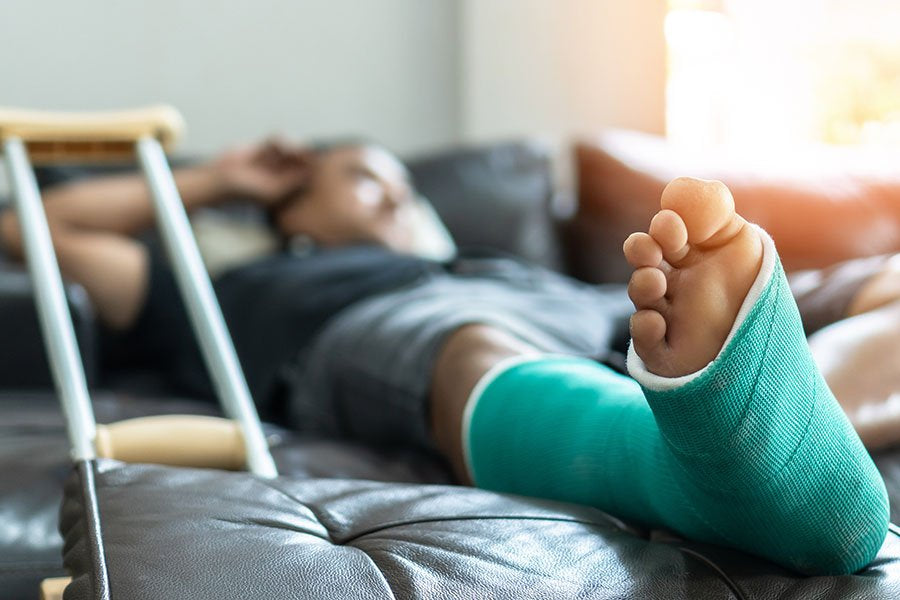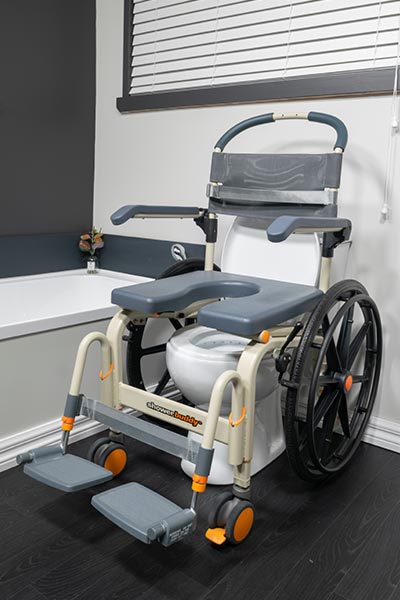-
When physical rehabilitation: is required
-
Physical rehabilitation is often required to assist the individual to regain their coordination and strength. While it’d be impossible to cover every injury type in a single guide, we do encounter certain types of injuries in our work as assistive equipment manufacturers that routinely present bathroom challenges. In this guide we’re going to talk about some of these injuries and the tasks they can prevent or affect.
-
![]()
Injuries: to limbs
-
Broken arm
A broken arm is an incredibly common injury worldwide, with millions of fractures occurring each year. While a broken arm is arguably less serious than a number of other injuries in this list, there’s no question as to just how much of an impedance having one functional arm can be on bathroom activities.
The severity of the broken arm can determine how much hand strength and control is affected, but initially there will be a need for help with at least parts of bathroom use:
- Preparing the cast for bathing – covering with plastic to prevent water from entering
- Drying oneself adequately (especially if a young child)
- Getting dressed after bathing
- Pumping shampoo or body wash
If you break your arm on the side that’s your ‘dominant’ side, meaning that which you usually rely upon to do the most coordinated of tasks, then there may be a learning process to become accurate with your non-dominant hand. Using the toilet is a good example of this from accessing the toilet paper to wiping. If you’re concerned about the ability to remain independent in the bathroom with a broken arm, discuss this with your doctor who may refer you to a physical or occupational therapist for a consultation.
Leg Injury
Leg injuries are usually more serious in terms of the bathroom implications they have. Having a stable base in a moisture-filled environment like the bathroom is really important. With a leg injury like a broken bone or torn ligament that base is compromised. Even if upper body strength is good, there are a number of movements in the bathroom where a lack of leg mobility can create hazards:
- Get into and out of the bath (a slippery edge without two feet on the ground is risky)
- Remaining centred and stable on the toilet
- Showering
- Using the basin and mirror at regular height
The support for a leg injury will most likely include some assistive technology whether that’s a shower seat, toilet riser or a complete bathroom mobility system. A support person should also make sure the bathroom is kept dry and free of ground tripping hazards. In a wheelchair, individuals with a serious leg injury may make sure of transfer benches and other products that allow for solo operation.
-
![]()
Neck and spine: injuries
-
Slipped Disc or Spinal Fracture
Spinal injury or broken vertebrae can be not only painful but prevent general mobility to the point that bathroom use is very difficult. Given the treatment can be everything from prescribed medication through to surgery, there are considerations both pre and post treatment to be made as it relates to showering and toilet use.
If the back injury leaves you in a brace or wheelchair, then the bathroom assistive equipment should mirror this level of daily mobility. Some of our back-affected rehab users of Showerbuddy opt for solutions like the SB2T TubBuddy Tilt, as the 30 degrees of tilt-back relieves pressure and aids comfortable bathing (with assistance).
A back injury can prevent your ability to respond quickly in the bathroom just as resetting your position when slipping, or the ability to reach for the shower head. While we’re unable to provide any specific details around how your back injury will manifest exactly in the bathroom routine, you should be able to get guidance from your OT and doctor about the best way to bathe and use the toilet with your level of mobility.
Broken Neck
It goes without saying that the impacts of a broken neck are serious. In some neck injuries, the loss or partial loss of mobility can affect hands, arms, and legs. Even if the impact is felt as numbness, the ability to keep controlled and stable in the bathroom can be drastically affected. As you might expect, a broken neck will often be kept stable in a brace to reduce the risk of further injury and support recovery of a fracture. But this brace can also mean that responding to or seeing hazards around a wet bathroom can be more difficult.
The severe neck injuries can manifest as complete paralysis for a period of time. In these situations the bathroom routine will need to rely on a good plan, carer and assistive equipment to support the individual’s body weight safely. If the injury has meant less mobility in arms and legs, but with the ability to still stand and walk, your OT or PT may still suggest making use of assistive equipment in the bathroom to counteract the reduced reaction time and strength.
As always, with any injury, the specific details around your recovery and care need to be discussed with your health professionals. Keeping to a rehabilitation (or care) programme is the best path forward.
When you need to rely on: a wheelchair
-
![]()
-
Lower body Injury
Loss of your entire lower body, whether that’s due to both legs being injured or something further up the body, will mean a reliance upon a wheelchair to get around. In the bathroom a quick trip to wash your hands might not be a problem, but more involved activities like using the toilet or taking a shower will need more than just your upper body strength to execute safely.
Lower body injuries are commonly a good fit for a proper shower transfer chair as the format is very familiar to someone operating a wheelchair. The added functionality being the unit can be transferred into a shower or over a toilet without having to get in and out of it. They’re built to be water resistant (as you’d expect!) and the transfer bridge design means that the lower body can be moved across the edge of a tub or shower without any issue. A tilting option can even move the user back to clear the edge without any help from a carer.
Complete or serious loss of mobility in your lower body makes equipment crucial. While some may be comfortable using their upper body strength in other parts of the house, the bathroom is a slippery and hazardous environment, meaning that trying to power through without support is a risky move.
Chat to your OT about what combination of support and equipment might be best for you if you are personally dealing with lower body injuries.
-
Shoulder injuries: can vary
-
Shoulder Injury
Shoulder injury like a torn rotator cuff, fracture or other muscle damage like an arm injury can be navigated around in the bathroom to some extent, but there’s more risk should there be a fall or slip without the control or strength to respond and correct.
Bathing can become difficult without some careful planning from an OT, and using the toilet can similarly be challenging. We have provided shower chair solutions to many people with serious shoulder injuries as the impairment prevents safe standing and moving around inside the tub or shower unit. Sitting down may alleviate pressure and allow focusing on bathing. It’s also common for those with shoulder or arm injuries to opt for other supports like pump soap, removable shower heads and grab bars. If you’ve incurred a shoulder injury, you’ll likely have a physical or occupational therapist working with you to determine a plan for daily tasks, including the showering and toileting process.
-
The impact of head injuries: can vary
-
Head Injuries
A head injury is hard to map directly to bathroom mobility, because the effects of this injury can vary so much.
In many situations, this type of injury can initially require considerable input from a support person and assistive technology, with the cognitive function or motor skills of the individual preventing solo use of the shower or toilet. For less severe instances, the occupational therapist may determine that parts of the bathroom routine can be carried out solo, with supports like a shower chair provided as an option should they require this.
-
Hip replacement recovery will need a: care plan
-
Hip Recovery
Recovering from a hip replacement is a common situation where assistive equipment is a must have in the bathroom.
As we’ve mentioned earlier in this guide, lower body control and strength in a slippery environment is important. Without this, someone recovering from hip replacement will need a care plan and equipment to help go to the toilet and bathe without reliance upon their legs. Even if the individual has good control and strength in other parts of their body, a shower chair or similar may provide the necessary stability to carry out these tasks.
More information: about this topic
You can find useful information about this topic across the web via the following excellent online resources:
- Types of Paralysis – WebMD
- Helping Someone with Chronic Back Pain Take a Shower or Bath – everydayhealth.com
- How Long After Surgery Before You Can Take a Bath – Verywell Health




